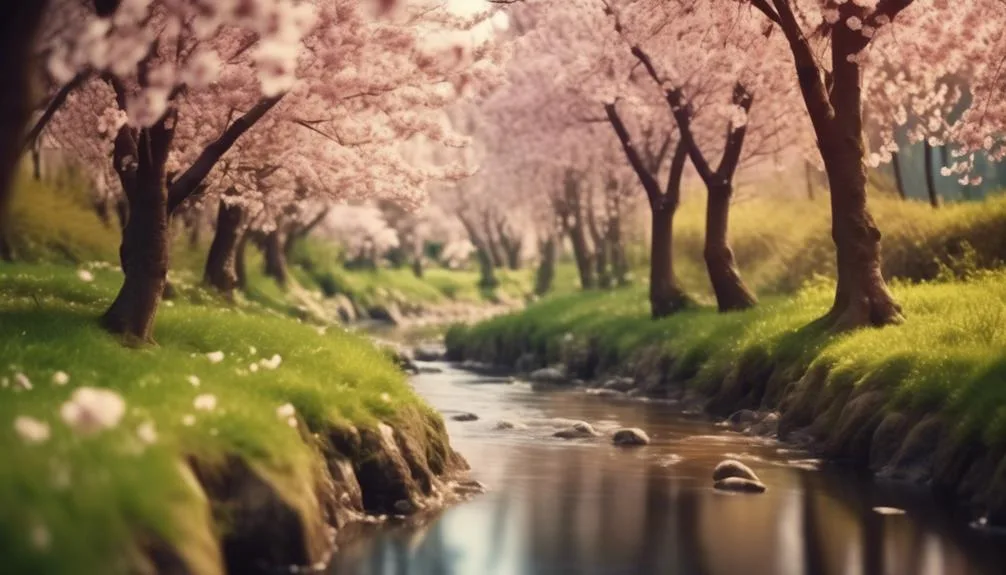Did you know there are over 1,000 types of cherry trees worldwide?
From the beautiful cherry blossoms in Japan to the tasty fruit from sour cherry trees, these trees have fascinated people globally.
But have you ever thought about where these trees grow naturally? Whether you love nature or are simply curious, understanding where cherry trees naturally occur can teach us a lot about their history and importance.
It's a fascinating topic worth exploring.
Cherry Trees Natural Habitat
Cherry trees naturally thrive in temperate climates, where they receive adequate sunlight and well-drained soil. Their natural habitat includes regions with distinct seasons, such as those found in parts of Asia, Europe, and North America. These trees are well-adapted to these environments, where they play a crucial role in the local ecology.
Cherry trees provide nectar for pollinators and their fruits serve as a food source for various animals. Additionally, their blossoms contribute to the beauty of the landscape and attract insects vital for the pollination process. The trees' roots also help prevent soil erosion, making them an essential part of the ecosystem.
Understanding the natural cherry tree habitat and its interaction with the environment is vital for preserving the delicate balance of these ecosystems.
Geographic Distribution of Cherry Trees
Amidst the diverse regions of Asia, Europe, and North America where cherry trees naturally thrive, their geographic distribution plays a significant role in shaping local ecosystems and providing essential resources for various organisms. Cherry tree cultivation has spread to different parts of the world due to their economic and cultural significance. Below is a table illustrating the geographic distribution of cherry trees across these continents:
| Continent | Countries | Notable Varieties |
|---|---|---|
| Asia | Japan, China, South Korea | Somei Yoshino, Prunus serrulata, Prunus avium |
| Europe | Spain, Italy, Germany | Prunus cerasus, Prunus avium, Prunus padus |
| North America | United States, Canada, Mexico | Prunus serotina, Prunus pensylvanica, Prunus virginiana |
The distribution of cherry trees reflects their adaptability to varying climates, enriching landscapes and offering fruits cherished worldwide.
Native Range of Cherry Trees
Naturally occurring across various regions of Asia, Europe, and North America, cherry trees have a rich and diverse native range that has contributed to their widespread cultural and ecological significance.
Here's a snapshot of the native range of cherry trees:
- Natural Environment: Cherry trees thrive in temperate climates, favoring well-drained soils and full sun, which is reflected in their native range across temperate regions of the northern hemisphere.
- Cherry Tree Species: The native range encompasses a variety of cherry tree species, including the famous Japanese cherry (Prunus serrulata) and the sweet cherry (Prunus avium), among others.
- Cherry Tree Cultivation: Understanding the native range is crucial for successful cherry tree cultivation, as it provides insights into the environmental conditions that support their growth.
This diverse native range has also exposed cherry trees to various diseases and pests, influencing their evolution and cultivation practices.
Cherry Trees in the Wild
Exploring the untamed beauty of the wild, you can observe cherry trees flourishing in their natural habitats, adding a touch of elegance to the surrounding landscape.
In the wild, cherry tree cultivation occurs naturally, with these trees thriving in various climates and terrains across the globe.
However, due to factors like deforestation and urbanization, cherry tree conservation has become increasingly important to preserve the natural habitats where these trees grow.
Efforts are being made to protect the wild spaces where cherry trees naturally occur, ensuring that these iconic trees continue to contribute to the biodiversity of their ecosystems.
Where to Find Wild Cherry Trees
To find wild cherry trees, you can venture into diverse landscapes, from woodlands to mountain slopes, where these elegant trees thrive in their natural habitats.
When searching for wild cherry trees, keep an eye out for these identifying features:
1) Distinctive Bark: Look for trees with shiny, copper-colored bark that develops horizontal lines as it matures.
2) White Blossoms: In spring, wild cherry trees are adorned with clusters of delicate white blossoms, making them easier to spot.
3) Fruit Inspection: During late summer, keep an eye out for small, dark cherries with a hint of red. These are a clear sign of wild cherry trees.
When foraging for wild cherry trees, remember to exercise caution and ensure proper identification before consuming any cherries.
Conclusion
As you venture into the northern hemisphere, keep an eye out for wild cherry trees. These trees not only add beauty to various regions, but they also contribute to the ecosystem. Take a moment to appreciate their natural beauty and importance.
What other wonders might await in the habitats of these cherished trees?
Happy cherry tree hunting!
Mark Hoffman is a dedicated arborist and tree care specialist with over a decade of experience. His love for trees began when he visited Yosemite National Park as a teenager and was awestruck by the giant sequoias. Mark pursued his passion by studying forestry at Michigan Technological University, where he earned a Bachelor of Science degree.
Since then, he has worked tirelessly in the field of arboriculture, helping to preserve and protect trees in his community. His expertise and dedication have made him a respected leader in the industry and a valuable resource for anyone seeking advice on tree care.
